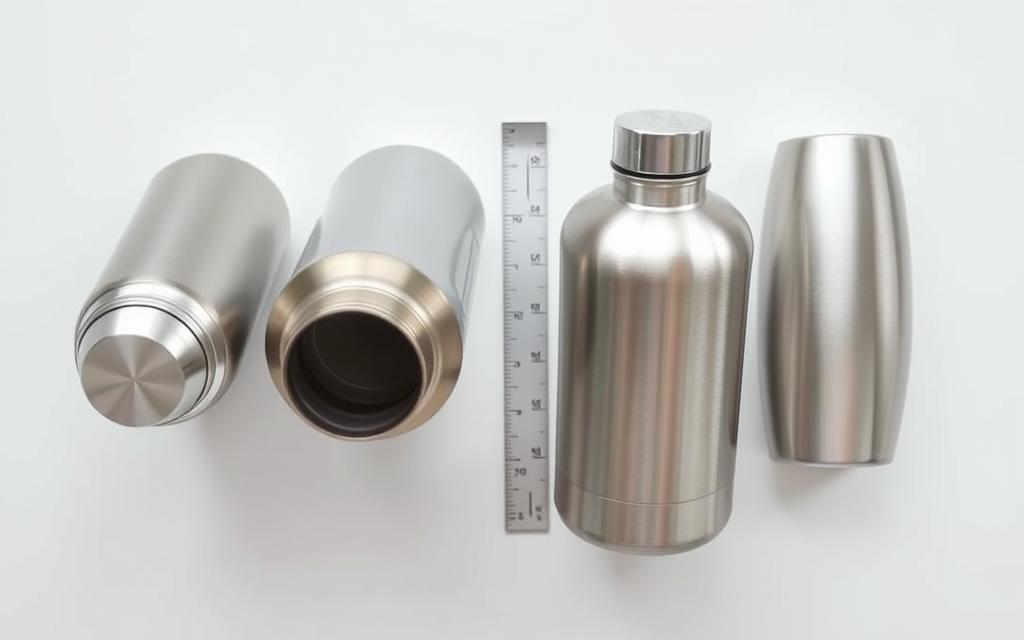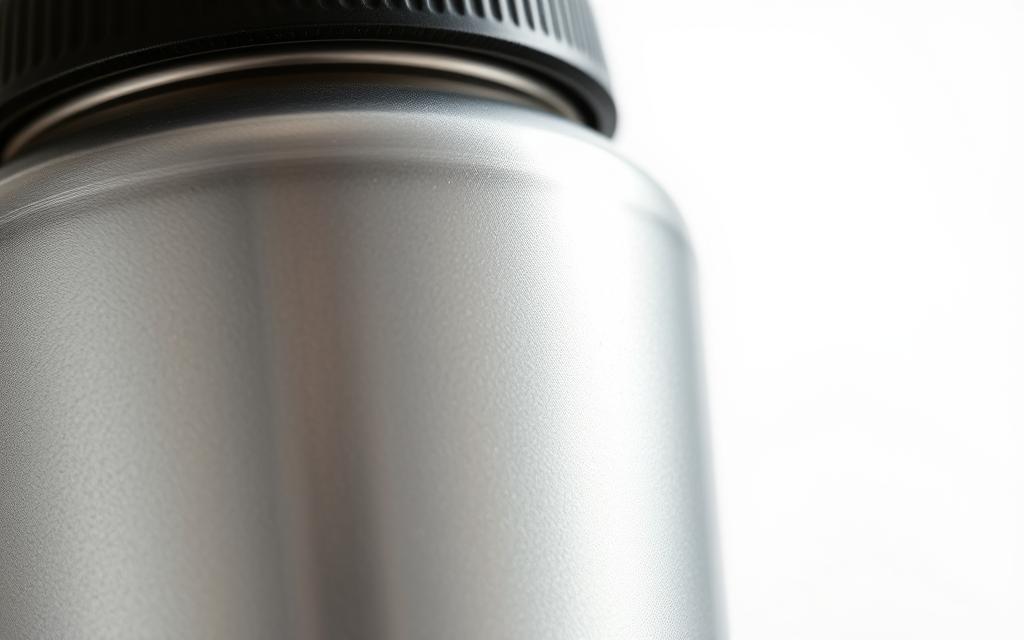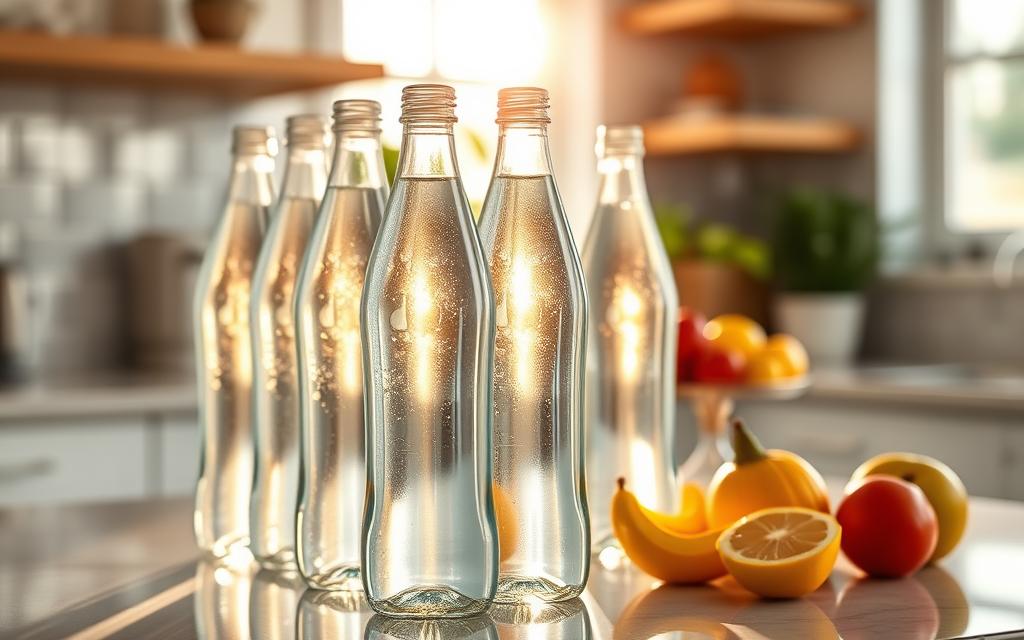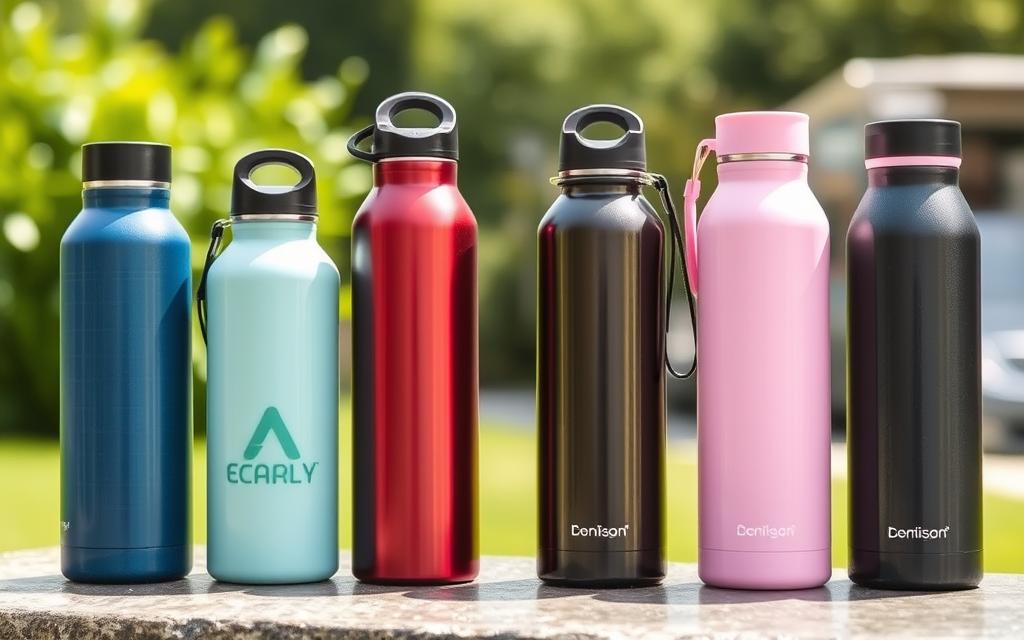Ever wondered what your water bottle is made of? It might look the same, but it could be a different material. This can change how your water tastes and how long the bottle lasts.
I’ve always been interested in knowing what my water bottle is made of. Aluminum and stainless steel might look the same, but they’re not. Each has its own special qualities for keeping your drinks fresh.
In this guide, I’ll show you how to figure out what your water bottle is. Whether you’re into fitness, love the outdoors, or just want to know more about your bottle, you’re in the right place. You’ll learn how to be a pro at figuring out your water bottle’s material.
Key Takeaways
- Simple tests can help identify your water bottle’s material
- Material composition affects bottle performance and durability
- Visual and physical tests provide quick material insights
- Understanding your bottle’s material helps with proper care
- Different materials have unique pros and cons for water storage
Understanding the Basics of Water Bottle Materials
When looking at water bottles, knowing what they’re made of is key. This helps you choose between aluminum and stainless steel. Each material has its own special traits that affect how you drink and how the bottle works.

Comparing water bottle materials shows interesting facts. Let’s dive into the main points of two common types.
Aluminum’s Unique Material Profile
Aluminum water bottles have some big pluses:
- They’re light
- They keep drinks hot or cold well
- They’re easy on your wallet
“Not all aluminum bottles are created equal – quality matters!” – Hydration Experts
It’s important to pick aluminum bottles with a BPA-free lining. Low-quality aluminum can leak harmful chemicals into your water.
Stainless Steel’s Superior Qualities
Stainless steel water bottles have amazing features:
- They don’t rust
- They last a long time
- They don’t react with anything
Top-notch stainless steel bottles keep your drinks safe. They make sure your water tastes clean and pure, without any metal taste.
Knowing these details helps you pick the right water bottle. It’s all about finding the best fit for your life and drinking habits.
Key Visual Differences Between Aluminum and Stainless Steel
Trying to tell if your water bottle is made of aluminum or stainless steel can be easy with visual clues. Knowing how to spot the difference in each material makes it simpler.
Color and Finish Comparisons
The first thing you notice about a water bottle is how it looks. Stainless steel bottles have a shiny, polished surface that looks like a mirror. Aluminum bottles, on the other hand, have a duller, matte finish that’s less refined.
- Stainless Steel: Shiny, smooth, highly reflective surface
- Aluminum: Matte, less glossy, slightly rough texture
Weight Differences
Another way to tell the difference is by feeling the weight. Aluminum bottles are much lighter. This makes them great for hikers, travelers, and anyone who doesn’t want to carry extra weight.
| Material | Average Weight | Typical Use |
|---|---|---|
| Aluminum | 120-200 grams | Outdoor activities, lightweight travel |
| Stainless Steel | 250-400 grams | Daily use, durability-focused applications |
By noticing these visual and touch-based differences, you can quickly figure out what your water bottle is made of. The shine, texture, and weight all give you clues about whether it’s aluminum or stainless steel.
Checking for Markings on Your Water Bottle
Figuring out what your water bottle is made of is easy once you know the signs. Knowing the material helps you understand its quality and safety. I’ll show you how to spot if your bottle is aluminum or stainless steel by looking at its labels.
Most water bottles have labels that tell you what they’re made of. These labels are usually found in a few places:
- Bottom of the bottle
- Near the bottle’s mouth
- Inside the bottle
- On the original packaging
Decoding Stainless Steel Markings
Stainless steel water bottles have special codes that show their grade. The most common markings you’ll see include:
- 18/8 – Means 18% chromium and 8% nickel
- 304 – Shows it’s food-grade stainless steel
- 18/0 – Has a different nickel mix
What These Markings Tell You
When I check the material, I focus on these numbers. The 18/8 marking is key because it means high-quality, food-grade stainless steel. It’s safer and lasts longer than many other materials.
Pro tip: Always check the manufacturer’s label for the most accurate material information.
If you can’t find any markings, don’t worry. You can also use the magnet test or look closely at the bottle’s surface and packaging. The important thing is to be careful and look well.
The Magnet Test: A Simple Method
The magnet test is a quick way to tell if your water bottle is made of aluminum or stainless steel. It’s a simple method that can help you figure out the metal type with little effort.
Why Magnets React Differently to Metals
Metals react differently to magnets because of their magnetic properties. This helps us tell aluminum from stainless steel water bottles:
- Aluminum is non-magnetic and won’t be attracted to a magnet
- Some stainless steel types are magnetic because they have iron
- The magnetic response varies based on the metal alloy
Conducting the Magnet Test at Home
To do the magnet test on your water bottle, just follow these steps:
- Get a strong rare-earth magnet
- Hold the magnet near the water bottle’s surface
- See how the magnet reacts
If the magnet sticks, your bottle is probably stainless steel or another magnetic metal. If it doesn’t stick, it’s likely aluminum.
Pro tip: Remember, not all stainless steel is magnetic, so this test isn’t 100% sure.
The magnet test is a fast way to guess your water bottle’s material. But for sure knowledge, use other methods or check the maker’s details.
Conduct a Sound Test for Material Identification
A simple sound test can tell you if your water bottle is made of aluminum or stainless steel. This method uses the unique sounds each material makes. It’s a fun way to figure out what your water bottle is made of.
Different metals have their own sounds when tapped. This can tell you a lot about your water bottle. It’s a cool way to find out what it’s made of.
The Acoustic Signature of Different Metals
Aluminum and stainless steel water bottles sound different when tapped:
- Aluminum makes a higher-pitched, crisp ring
- Stainless steel sounds deeper and more muted
- The sound changes based on the metal’s density and structure
Performing the Sound Test Effectively
To find out what your water bottle is made of, just follow these steps:
- Hold the water bottle by its body
- Tap the side gently with a fingernail or light object
- Listen to the sound it makes
- Compare the sound’s tone and how it resonates
The sound test isn’t the only way to know, but it’s a fun method. Use it with other ways to get the most accurate answer.
Thermal Conductivity Insights
Learning about your water bottle’s material is key. It’s important to know how it handles temperature. This helps you figure out if it’s aluminum or stainless steel.
How a water bottle keeps temperature is a big clue. Stainless steel bottles are great at keeping drinks at the right temperature. They’re a favorite among those who love their drinks just right.
Understanding Heat Retention Characteristics
Stainless steel water bottles are top-notch at keeping drinks at the right temperature. They have double-wall insulation. This means they can keep drinks cold for up to 12 hours or warm for about 8 hours.
- Cold beverages stay chilled for up to 12 hours
- Hot drinks remain warm for approximately 8 hours
- Minimal external condensation or temperature transfer
Testing the Temperature of Your Beverage
Try a simple test at home to find out what your water bottle is made of. Fill it with hot or cold liquid and watch for these signs:
- See how fast the outside temperature changes
- Check how long the inside temperature stays the same
- Look for any condensation or heat transfer on the outside
Aluminum bottles usually lose heat faster. Stainless steel keeps it better. This test shows you how your bottle handles temperature and what it’s made of.
Evaluating Durability and Longevity
Durability is key when comparing water bottles made of aluminum and stainless steel. These materials show how well they last and perform over time.
Stainless steel water bottles are much more durable. They can handle big impacts without breaking. Here are the main reasons why:
- Impact Resistance: Stainless steel bottles can take more physical stress
- Temperature Tolerance: They can handle extreme temperatures
- Structural Stability: They keep their shape even when things get tough
Comparing Resistance to Dents and Dings
Aluminum water bottles are lighter but more prone to dents and scratches. They need more care than stainless steel bottles.
Rust and Corrosion Resistance
Stainless steel bottles don’t rust, making them great for long use. Aluminum bottles need special coatings to avoid rust and keep looking good.
The right water bottle isn’t just about material—it’s about matching your lifestyle with the most suitable performance characteristics.
Your choice depends on what you need. Stainless steel lasts longer, but aluminum is lighter for certain uses.
The Price Factor: Cost Differences
When looking at aluminum vs stainless steel water bottles, price is key. It shows a lot about the bottle’s quality and what it’s made of.
Prices for water bottles change a lot. This is because of several important things:
- Material quality
- Manufacturing process
- Brand reputation
- Design complexity
Typical Price Ranges Unveiled
Aluminum water bottles usually cost between $10 to $25. They are a good choice for those on a budget. Stainless steel bottles, on the other hand, cost more, from $15 to $50. This is because they are more durable and made with advanced techniques.
“The price of a water bottle isn’t just a number—it’s a story of materials, craftsmanship, and performance.”
Understanding Price Variations
High-quality stainless steel bottles are often more expensive. This is because they:
- Resist corrosion well
- Keep drinks hot or cold longer
- Last longer
- Are made with great precision
Buying a more expensive stainless steel bottle might save you money in the long run. It’s durable and performs well.
Understanding Safety Standards and BPA Content
When looking at water bottles, safety is key. Different materials have their own health risks. It’s important to know what you’re getting.
Stainless steel water bottles are a top pick for those who care about health. They have many safety benefits:
- Completely free from BPA (Bisphenol A)
- No toxic chemical leaching
- Resistant to bacterial growth
- Non-reactive with beverages
Is Stainless Steel Really Safer?
Research shows stainless steel water bottles are very safe. Medical-grade stainless steel means no harmful chemicals get into your drink. This makes them a great choice for those who value health.
BPA-Free Water Bottle Certifications
When picking a water bottle, look for BPA-free certifications. Stainless steel bottles usually have third-party testing. This proves they are safe for you.
Not all water bottles are created equal – your health matters!
Knowing about safety standards helps you pick a water bottle that’s good for you. It keeps you healthy and hydrated.
Eco-Friendliness of Both Materials
When choosing between aluminum and stainless steel water bottles, knowing their environmental impact is key. My research shows how these materials stack up in terms of sustainability.
The environmental impact of water bottles differs between aluminum and stainless steel. Let’s look at the main differences:
Recycling Challenges and Opportunities
Aluminum water bottles face recycling hurdles. They are recyclable, but many have inner linings that make recycling hard. Not all aluminum bottles are 100% recyclable, which affects their green credentials.
- Aluminum needs a lot of energy to make
- Recycling rates for aluminum vary by area
- Some coatings stop full material recovery
Stainless Steel: A More Sustainable Choice
Stainless steel is a greener option. It’s durable and almost fully recyclable, making it great for those who care about the planet.
- Stainless steel can be recycled forever
- It takes less energy to recycle than to make it
- It keeps its quality with each recycling
Knowing these environmental facts helps you choose better. You can pick a water bottle that meets your needs and is good for the planet.
Making My Choice: Which Material is Best for Me?
Exploring water bottle materials has taught me a lot. It’s not just about knowing what your bottle is made of. It’s about finding the right one for your life.
Aluminum and stainless steel have their own benefits. They can change how you stay hydrated every day.
Choosing the right material depends on several things. If you love the outdoors and want something light, aluminum might be for you. But if you need something that lasts, stainless steel is the way to go.
Think about where you’ll use your water bottle. Do you go to the gym, hike, work, or travel a lot? This will help you decide.
Safety and the environment are also important. Stainless steel is better at resisting corrosion and is safer. It’s also good for the planet because it’s recyclable.
Choosing the right water bottle is a personal choice. By knowing the differences between aluminum and stainless steel, I can pick the best one for me. This ensures my water bottle is always up to the task.



